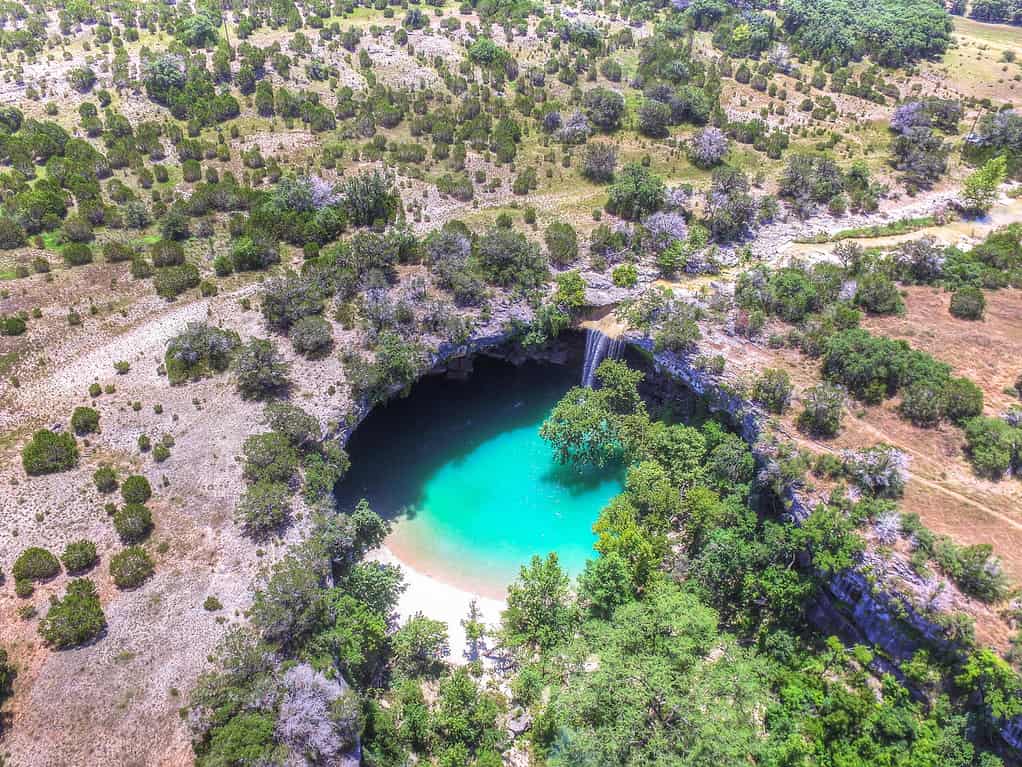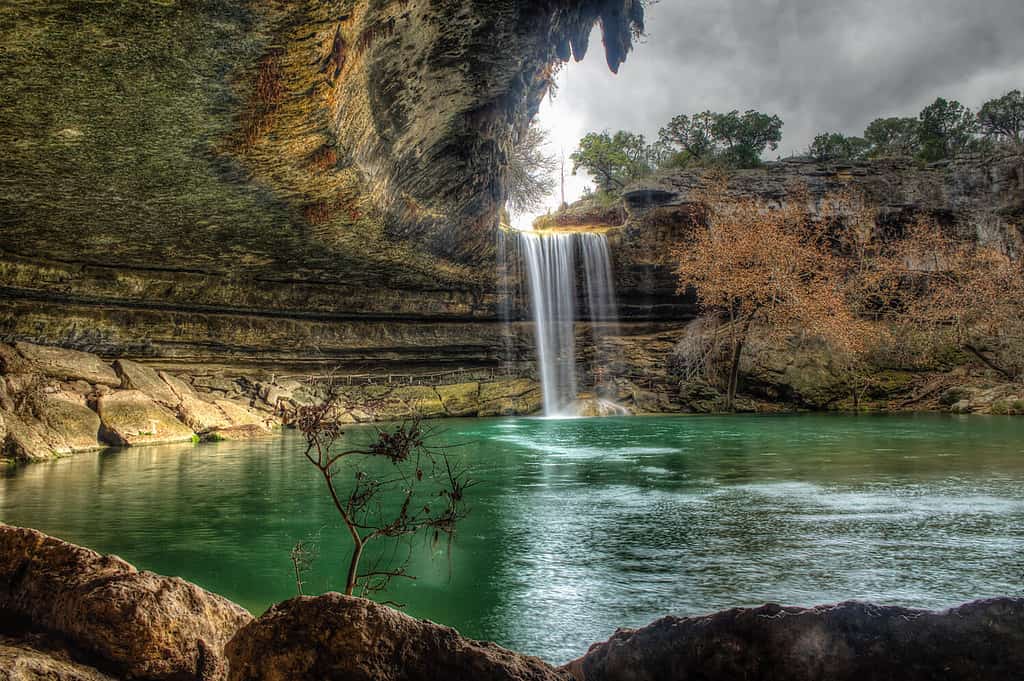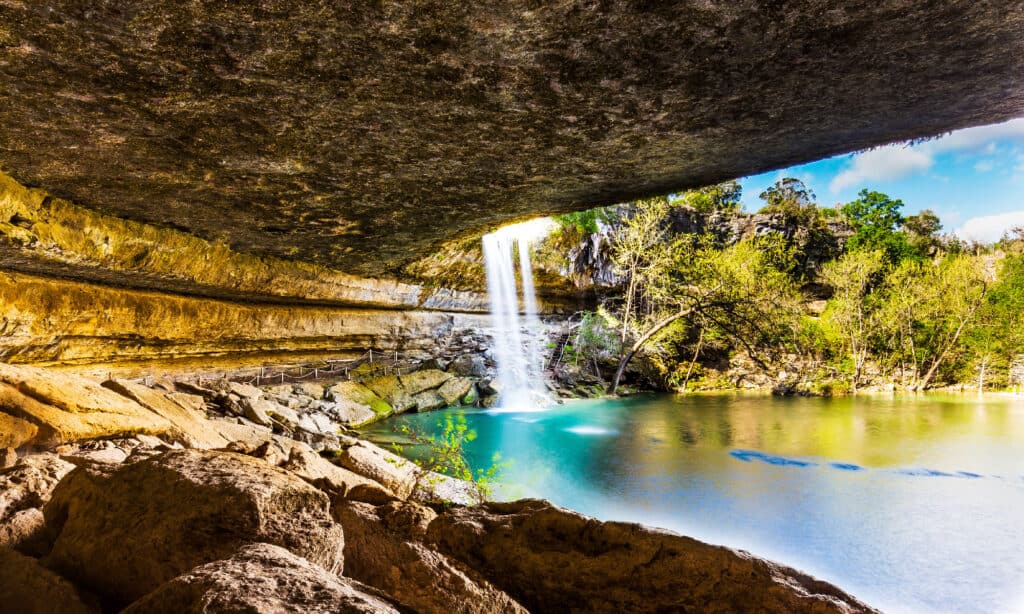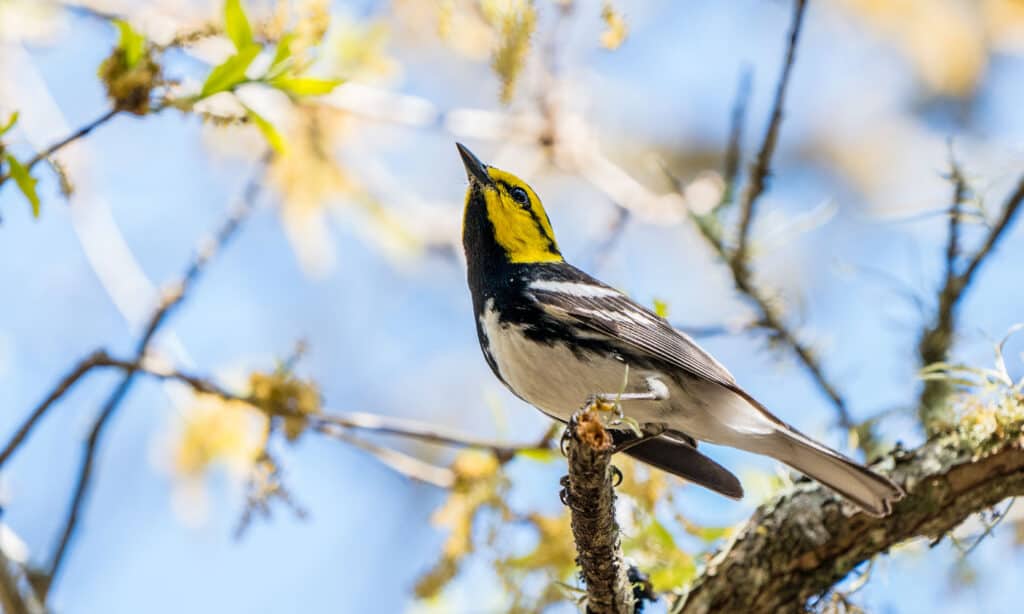This stunning limestone grotto nestled in Texas Hill Country has been a popular swimming hole since the 1960s. Otherworldly beautiful, the natural pool has been an iconic Texas attraction for decades. Imagine a 50-foot waterfall dropping from a mossy stone overhang into emerald-green waters. A pebbly beach lines the pool, while the banks are surrounded by lush vegetation. The crystal clear waters reveal fish and turtles swimming by.
How did this oasis in the middle of a harsh Texas landscape form? Read on to learn all about how and when the Hamilton Pool in Texas was formed.
The History of the Hamilton Pool in Texas

Thousands of years ago, erosion caused the roof of a cave to collapse, revealing an emerald-green, crystal-clear grotto.
©Mike Holp/Shutterstock.com
The Hamilton Pool was formed roughly 10,000 years ago when a dome covering an underground river collapsed, creating the grotto. Although experts can’t pinpoint the exact date, cultural remains from the area date back 8,000 years ago.
The pool became a favored swimming hole from the 1960s to the 1980s. However, due to the many visitors and no restrictions, the land began to suffer from overuse. Officials designated the area to be the Hamilton Pool Preserve in 1990 to help protect the environment. Today, aggressive measures such as prairie restoration, water quality monitoring, surveys for endangered species, and prescribed burns help sustain the ecosystem.
Hamilton Pool Preserve Today

Visitors can hike a scenic trail from the pool to the Pedernales River.
©Greg Browning/Shutterstock.com
Today, visitors can hike the preserve trails, or take a dip in the pool. The Hamilton Pool is fed by the Hamilton Creek as it drops down the head of the box canyon creating a 50-foot waterfall. After a rainfall, the waterfall can be very impressive, but dries to a slow trickle during droughts. However, even when there hasn’t been much rain, the pool tends to stay at a constant level most of the time.
Guests should check the website before they go. Swimming in the pool is sometimes closed due to bacteria levels. Also, the area is currently facing a hazard of falling rocks from the rocky overhang into the water, restricting how much of the pool is open for swimming. Reservations are required, and the number of people allowed in the preserve is limited.

The water in the pool can drop water below 50 degrees Fahrenheit in the winter and spring.
©Brett K/Shutterstock.com
The pebbly beach area is open to the public, where visitors can get a spectacular view of the emerald-green waters and the limestone slabs above. The cliffs are covered in ferns, moss, and cliff swallows. Large stalactites hang from the rocky ceiling. A trail leads directly behind the waterfall giving hikers a different perspective. Although at the time of this writing the area is closed due to falling rocks.
Where Is the Hamilton Pool Preserve on the Map?
Located at 24300 Hamilton Pool Road, the preserve is about 45 minutes west of Austin and inside the Balcones Canyonlands Preserve (one of the nation’s largest urban preserves.) The Pedernales River flows into Hamilton Creek, which spills over the limestone outcropping into the grotto. To access the pool, visitors must hike a quarter-mile-long trail from the parking lot. The trail is a short but challenging hike, with many narrow steps leading up a steep path to the grotto.
Wildlife in the Hamilton Pool Preserve

Various cave-dwelling creatures make their home in the area.
©Jason Stitt/Shutterstock.com
The pool is located in a delicate ecosystem with a diverse amount of wildlife. A popular spot for bird watchers, some of the birds you may see in the preserve include the endangered golden-cheeked warbler, canyon wrens, Acadian flycatchers, and the Louisiana waterthrush.
The water in the pool is so crystal clear that you can see turtles and fish swimming around you. Fish found in the water include largemouth bass and bluegill.
Some of the mammals you will spot in the area include skunks, foxes, possums, white-tail deer, porcupines, and bobcats.
The Balcones Canyonlands Preserve

The golden-cheeked warbler only lives in Texas Hill Country where it nests in juniper-oak woodlands.
©Michael Armentrout/Shutterstock.com
The Hamilton Pool Preserve is located within the Balcones Canyonlands Preserve, which is 33,000 acres (or 50 square miles) of protected land. The land protects eight endangered species and 27 species of concern. The endangered species include the following.
The Golden-Cheeked Warbler
This small, vibrantly colored songbird nests almost exclusively in the central region of Texas. It breeds in mature oak-juniper forests. The juniper trees are essential to the warbler’s survival.
Six Cave-Dwelling Invertebrates
There are six cave-dwelling invertebrates on the endangered list which include:
- Tooth cave spider
- Tooth cave pseudoscorpion
- Tooth cave ground beetle
- Bee Creek cave harvestman
- Bone cave harvestman
- Kretschmarr cave mold beetle
The Jollyville Plateau Salamander
This small, aquatic salamander retains its gills throughout its life. It is an endangered species due to habitat loss from urban and suburban development and is only found in the wet springs and caves of Travis and Williamson counties in Texas.
The photo featured at the top of this post is © Jason Stitt/Shutterstock.com
Thank you for reading! Have some feedback for us? Contact the AZ Animals editorial team.







